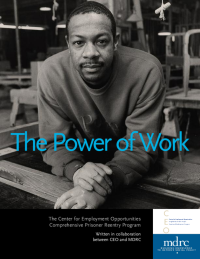The Power of Work
The Center for Employment Opportunities Comprehensive Prisoner Reentry Program
States and localities across the United States are feeling the aftereffects of a 25-year incarceration binge. In a period of just 15 years, from 1980 to 1995, the number of people incarcerated in federal and state prisons and local jails more than tripled, from about 500,000 to more than 1.5 million. Today, more than 2 million people are behind bars nationwide. Since almost all prisoners are eventually released, an incarceration boom necessarily translates into a reentry boom. In fact, more than 600,000 people are released from prison each year. Unfortunately, most end up back in the criminal justice system before long. With state and local budgets strained by the high cost of incarceration, breaking the cycle of recidivism is one promising way to shrink the prison population — as well as to increase public safety and to improve the well-being of former prisoners, their families, and their communities.
Ex-prisoners face a daunting set of obstacles to reentry, but securing employment may be the biggest challenge of all. The unemployment rate of formerly incarcerated people one year after release may be as high as 60 percent, and there is an increasing reluctance among employers to hire people with criminal histories. Further, studies show that inmates reentering communities are most vulnerable to failure in the early stages after release from jail or prison. Since the late 1970s, New York City’s Center for Employment Opportunities (CEO) has addressed the relationship between work and crime. Through a highly structured program of pre-employment training, immediate short-term transitional employment, and full-time job placement services, CEO helps close to 2,000 men and women each year to take the crucial first steps toward staying out of prison and returning to their families and communities. MDRC is conducting a rigorous evaluation of CEO’s program as part of a multi-site project, Enhanced Services for the Hard-to-Employ Demonstration, funded by the U.S. Department of Health and Human Services and the U.S. Department of Labor.
With generous support from the JEHT Foundation, MDRC and CEO have written this overview of the CEO program. First, it discusses the link between unemployment and recidivism. Second, it lays out the “what” of the program: CEO’s company philosophy and the four phases of the CEO program. Then it discusses the “how” of the program: how it came to be, how it appeals to key stakeholders (including government agencies and private employers), and how its financial and organizational structures keep it strong. The document concludes with case studies to illustrate early examples of how CEO’s model is being replicated and adapted for use in other jurisdictions or with other populations.






